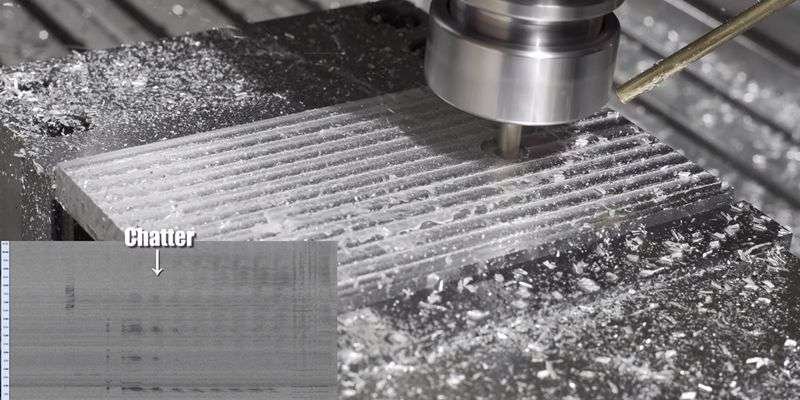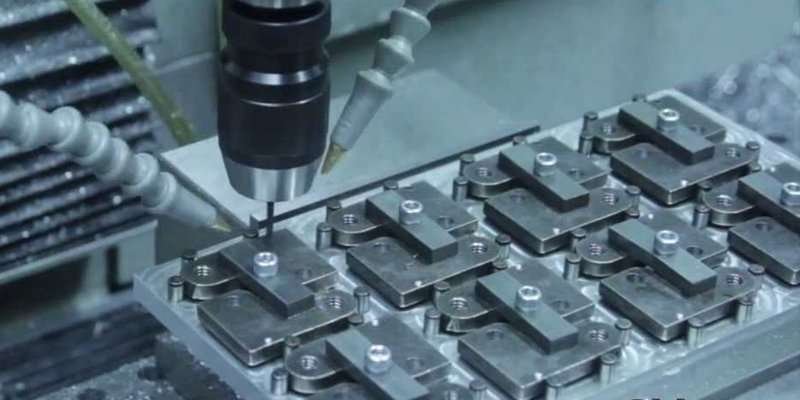Over the years, many industries have explored the application of CNC technology on different metals, and one such metal is brass. An alloy of copper and zinc, brass is a versatile metal widely used in the manufacturing industry because of its unique properties.
There are many benefits, especially when machining complex brass parts. However, you should take important considerations before machining brass. Let’s get it!
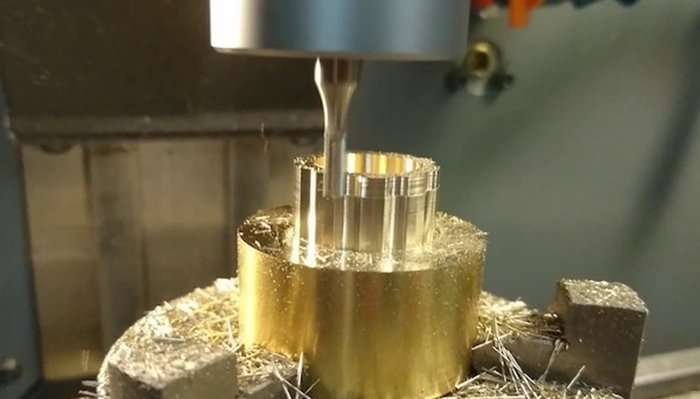
Table of Contents
ToggleWhat is CNC Machining Brass?
Brass CNC machining is a specialized manufacturing process that uses Computer Numerical Control (CNC) technology to automate the cutting, shaping, and fabrication of brass machine parts. The finished brass parts have a high degree of accuracy and precision that will be otherwise difficult to achieve manually.
While there are several established advantages of manufacturing brass parts using CNC, certain considerations are necessary before actually embarking on the machining journey. These considerations include the properties of the brass itself, the different brass grades and types, and the right CNC technique.
Key Properties of Brass that Make it Suitable for CNC Machining
Despite the advantages of accuracy, speed, and efficiency of CNC machining over traditional machining methods, not all metals can be CNC processed. However, one of the suitable metals for CNC machining is brass, and this is due to its great properties.
Excellent Machinability
Machinability is the ease with which a material can be cut (machined) with a cutting tool. The higher the machinability of a metal, the easier the large-scale production of the metal’s parts. Brass is known for its excellent machinability, making it ideal for CNC machining. One of the reasons for the high machinability of brass is its lead content.
Corrosion Resistance
Brass has high corrosion resistance, which is always desirable when manufacturing parts. The primary reason for brass’s high corrosion resistance is that it is a non-ferrous metal, which means it does not naturally contain iron.
While there may be iron among the brass components, depending on the alloy type, this amount is too small to alter the corrosion resistance of brass. Further, the high copper content and presence of aluminum in some brass types can form protective layers around the metal, further boosting its ability to resist corrosion.
Aesthetics
Aesthetic appeal is one of the essential properties manufacturers consider in CNC brass machining. Therefore, it is unsurprising that brass is common among CNC manufacturers, as it has a visually appealing golden hue. While bright gold is the most common appearance, depending on the constituents and proportions, brass can also be reddish gold, silvery-white, or rose gold.
Physical appearance also goes beyond color, as factors like texture and surface finish also contribute to aesthetics. Brass also excels in these properties, justifying its use in CNC machining for decorative purposes.
Malleability
The malleability of a metal is its ability to be drawn into wires and different shapes without breaking. Brass is a very malleable metal, making it an excellent candidate for CNC machining, as machinists can easily manipulate it into desired shapes.
The high malleability of brass is due to its high copper content (67%), as seen in copper CNC machining. Therefore, brass alloy types lower in copper content will not be as malleable as others.
Conductivity
Brass has higher thermal and electrical conductivity than many other metals, and this is also due to its high copper content. In CNC machining, materials with high electrical conductivity are not only useful in designing specialized conductors but also for their ability to dissipate heat.
Types of Brass Alloys Used in CNC Machining
Different brass grades are used in CNC machining, each offering unique properties for specific applications. Some of the typical brass alloy types used include:

C260 Brass
Also known as cartridge brass, C260 brass has about 70% copper and 30% zinc. Cartridge brass is common among CNC machinists for multiple reasons, including their strength, ductility, and conductivity.
Advantages
- Useful for CNC operations requiring extensive bending, drawing, or forming
- Cost-effective
- Exceptional cold workability
Disadvantages
- Susceptible to stress corrosion cracking
C360 Brass
This brass type is also known as free-cutting or free-machining brass, containing up to 3% of lead. The lead proportion in the C360 brass alloy type is higher than in regular brass alloys, corresponding to a significant improvement in machinability.
Advantages
- High corrosion resistance
- Suitable for operations that demand precise tolerances
- Can withstand higher stress and loads than most brass alloys
Disadvantages
- A little expensive
C220 Brass
C220 brass is commonly known as commercial bronze, which is interesting because it is still regarded as a brass alloy type. It is common in the architecture and jewelry manufacturing industries, as it has a rich color, strength, and corrosion resistance.
Advantages
- Excellent formability
- High corrosion resistance, making it suitable for marine parts
- Aesthetically pleasing, so useful for jewelry
Disadvantages
- Can still corrode in harsh conditions, requiring additional annealing treatment
C464 Brass
Also known as naval brass, C464 contains around 60-63% copper, 37-40% zinc, and a minor proportion of tin (less than 1%). As the name suggests, naval brass is commonly used for machining brass parts for marine purposes.
Advantages
- High corrosion resistance, even in seawater
- Useful for producing strong brass parts
- Resistant to dezincification (the selective removal of zinc from an alloy)
Disadvantages
- Can discolor when exposed to water for extended periods
Common CNC Machining Techniques for Manufacturing Custom Brass Parts
CNC machining offers a wide range of techniques that can be used to manufacture brass machine parts. Of the several techniques that exist, mill-turn machining is the most common.

CNC Milling
This CNC machining process produces custom-designed machine parts by removing materials from the workpiece using rotational cutting tools. When machinists CNC mill brass, the brass workpiece remains stationary while the cutting tool rotates.
CNC milling is performed with machines that utilize different axes, like the 3-axis, 4-axis, and 5-axis machines. The 5-axis milling machines offer the greatest flexibility, as the cutting tool and the brass workpiece can rotate and move simultaneously. Therefore, 5-axis CNC milling can be used to produce brass parts with very complex geometries like those found in the aerospace and medical industries.
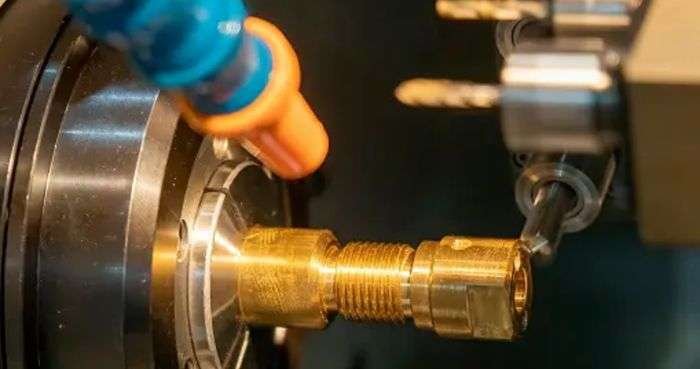
CNC Turning
This machining technique can produce custom machine parts by removing materials from a workpiece using a stationary cutting tool. In contrast to CNC milling, in CNC turning, the brass workpiece rotates while the cutting tool does not move.
There are different types and configurations of CNC turning machines, usually depending on the number of turrets and spindles they have. CNC turning is particularly suitable for manufacturing brass parts that are cylindrical or hollow.
Surface Finishing Options for CNC Machined Brass
After CNC machining materials, there is still a vital step of removing irregularities from the part’s surface, increasing its appearance and aesthetic appeal, and even improving its functionality. This step is known as surface finishing, and there are various finishing options for brass parts.
Natural/As-Machined Finish
With this finish, the machined brass parts are used without applying any surface finish. This makes sense from an aesthetic perspective, as brass is naturally visually pleasing. Machinists also use an as-machined finish for consistency between different batches and tight dimension tolerances.
However, a downside to the as-machined finish is an increased risk of damage, as there is no protective external layer to shield the brass part from harsh conditions. Moreover, there may be visible marks on the brass parts with an as-machined finish.
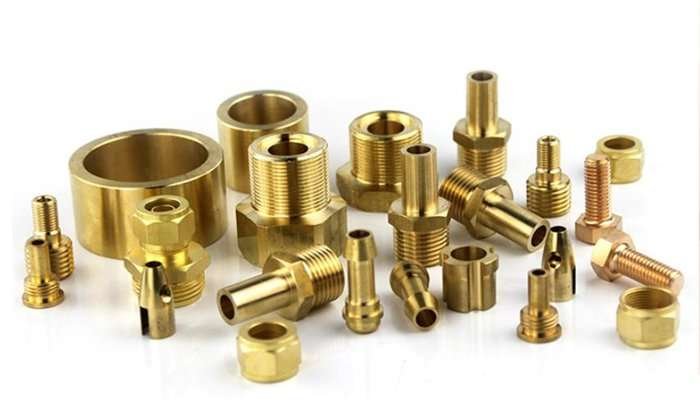
Polishing
This is one of the common surface finishing techniques, usually creating a smooth and shiny finish. The polishing surface finish technique works on the principle of abrasion and typically utilizes abrasive machining processes. This technique can be mechanical or chemical.
While polishing is standard among machinists because of its simplicity, there are concerns with its durability. Also, chemical polishing is relatively costly, and even more so when the brass parts have complex geometries.
Brushed Finish
This is another simple surface finishing option for brass CNC machining, involving using abrasive materials or metal-wire brushes to create parallel lines on the brass part. This technique is perfect for concealing scratches and making textured appearances.
However, there are limitations to this technique, including the high risk of damage, especially with intricate brass parts. Furthermore, the brushing process becomes much more difficult and time-consuming with components that have complex geometries.
Powder Coating
This technique involves electrostatically spraying dry powder on electrically charged custom brass parts. The purpose of electrically charging the brass part is to cause the free-flowing powder to stick to the metal surface. There are many benefits to this finishing technique, including improvements in durability and versatility, shorter time for finishing, environmental friendliness, and high color variation.
Still, using powder coating as a surface finish for brass parts is curtailed by its high cost. Also, it may be tricky to get extremely thin coats, which is a major disadvantage in parts with high tolerance demands and complexities.
Challenges and Tips for Brass Machined Parts
Brass CNC machining offers many benefits, but it is not all smooth sailing. There are challenges machinists may encounter when machining brass parts. It is essential to know these challenges and the tips for overcoming them.
Challenges for Machining Brass Parts
Below are some challenges that operators face when CNC brass machining:
Tool Wear
Brass has excellent machinability, meaning it can be turned at high speeds and feeds. However, when the speed gets too high or too low, tool wear may occur. This then reduces the efficiency of the machining process, as well as productivity.
Overheating
Brass has a low melting point and high heat conductivity. This implies that there is the risk of the brass workpiece retaining high amounts of heat when machining due to friction and the high rotation speed of the cutting tool. The subsequent overheating can cause deformation of the workpiece and the cutting tool.
Chip Formation
Some grades of brass, like C360 brass, are susceptible to high chip formation when machining. These chips are long and continuous, and can easily break during the machining process. Chip breakage and accumulation can cause jams in the CNC machine, reducing efficiency and productivity.
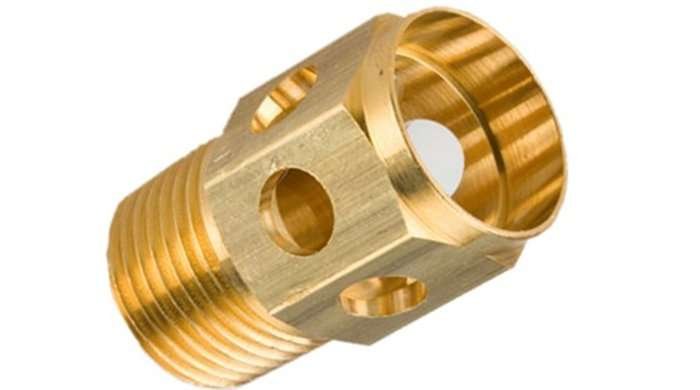
Tips for Machining Brass Parts
Here are some tips for efficient CNC brass machining:
Use Proper Cutting Tools
Generally, carbide or high-speed tools are the preferred options, with coatings like TiN (Titanium Nitride) or TiCN (Titanium Carbonitride) to increase hardness and reduce friction. While carbide tools offer better resistance to tool wear, as well as higher cutting speeds, they cost more than high-speed tools. Also, high-speed tools are more durable than carbide tools.
Invest in Proper Cooling Methods
During brass CNC machining, there is the risk of overheating in the machining device due to friction and the high rotating speed of the cutting tool. It is necessary to keep temperatures controlled to prevent a decrease in productivity, and coolants and lubricants are generally the best options for operators. Coolants and lubricants can also aid in chip evacuation. However, there are different coolant types, and choosing the right one depends on the brass grade, tool type, and machining environment.
Surface Finish Consideration
If a surface finish is going to be applied to the brass part, it is critical to use the right finishing technique and the appropriate tools for that technique. Polishing, brushing, and coating are the commonest surface finishes applied to brass parts, but it is necessary to maintain good quality control over the finishing process. This involves testing the machined parts to ensure they conform to the right dimensions, functionality, and tolerance.
Applications of CNC Brass Machining
Brass CNC machining is useful in the mechanical, decorative, and even medical industries. With this procedure, the following parts can be created:
- Valves
- Jewelry
- Nozzles
- Hinges
- Knobs
How to Determine if Brass is the Ideal Selection for Your CNC Project?
Determining whether brass is ideal for your CNC project requires careful consideration. It is crucial to consider the use of the final part, which informs the requirements of properties like strength, malleability, conductivity, etc.
However, it may be tricky for you to judge or assess these properties properly, but we at XinCheng are here for you! We are experienced in custom CNC machining and have a lot of expertise in choosing the right materials for a CNC project. With 3, 4, and 5-axis machining capabilities, we can make complex machined parts with high precision and tolerance to meet your any specific needs. Just contact us today and start a new project!
Read more: Methods for Making Metal Prototypes
Conclusion
CNC machining brass is a specialized process that utilizes computer numerical control technology to automate the fabrication of brass parts. Brass’s excellent machinability, corrosion resistance, and aesthetics make it suitable for CNC projects. However, challenges like selecting the right brass grade and surface finishing options must be considered.
FAQ
What is the best brass alloy to use for brass machine parts?
This depends on the eventual application of the brass part, as different alloys have their specialized uses. C360 is the best for machinability, while C464 is the best for marine purposes.
Is brass suitable for machining?
Yes, brass has an excellent machinability rating and is suitable for the manufacture of intricate and low-friction components.
Do brass parts corrode faster than steel?
No, brass is highly corrosion-resistant because it is non-ferrous. On the other hand, steel is an iron alloy and is more susceptible to corrosion.

